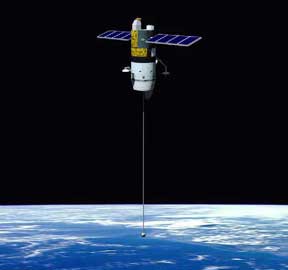Space Travel
Alright, let's start with the basics. To make a space opera, you have to get to space. Now, us humans have already done that... but in just about the single most innefficient way possible. We jam-packed a bunch of metal tubes with straight Hydrogen and lit it all on fire to explode a few lucky individuals into low Earth orbit. The Apollo 11 mission's Saturn V rocket was the most powerful boi ever to be yeeted into space, and burned TWENTY TONNES of fuel per SECOND as it was launching. The propellant accounted for 85% of the rocket's total weight.
It took four days to get to the moon, and of the 110.6 meters of rocket that was launched initially, about ten or so actually held the astronauts. 15% by weight included the actual rocket, and less than 10% made up the bit that dropped Mr.'s Armstrong and Aldrin onto the lunar surface.
I don't think I should have to say that we can do better than that.
Step One: Railguns
Using the physics and engineering that we know and love, our beloved NASA scientists have come up with quite the solution to the whole "rockets suck" problem. All they need is two miles of train track, a cargo jet of X-Plane caliber, and enough power to run a small town.
Railguns use electromagnetism to propel objects. It's the same as any old magnet: you put south at south and they push each other apart. However, electromagnets can control for how much power this magnet has, meaning the more electricity you pump into it, the more force they push at each other with.
Thus, you put a massive coil thingy engine mcbobber (I'm no technician; I don't know the details) at the end of the track and stick your plane (called a Scramjet, apparently) right there full of its stuff. Then you fire up the electromagnet, and YEET the scramjet down the track. Two miles would give it more than enough time to get up to speed (mach four), and then hurls the jet off the end. The incredible air pressure ignites the fuel in the chamber required to get it higher in the air, eventually getting the scramjet up to Mach 10. At 20,000 feet, the jet can't continue flying ('cause there isn't any... y'know... air); so this is where spaceflight begins.
The scramjet fires its payload into space, then glides back down to Earth for reuse (it was projected that such a machine could be ready for use again in just twenty-four hours).
From here, NASA projected that the payload - in the example situation, it was a satellite of comparable mass to the moon lander - would be in orbit in just a day, and with the same railgun they could send men to the moon on the next.
But that's just the first step. Maybe that works for getting things off the ground, but that's nowhere near enough for a full-on space opera. You can't have incredibly epic space battles if it takes years just to reach the next planet over.
So this is where our next epic physics boi comes in.
Step Two: Trebuchets
(hopefully the image actually does its thing)
This is a trebuchet. It uses the most basic physics to do the most awesome thing ever: yeet things. On one side, you have your payload, whether that be a boulder, a cow, or a flaming bag of dog poo. On the other side, you have a counterweight. You lock the thing in place to load up your boulder, then unlock it to have the weight heave down and catapult the boulder into enemy lines. What's more, the engineering of these things only ever improved, increasing accuracy, distance, and power.
So, naturally, we're gonna put one in space.

This is the Skyhook. It's a really, really long cord (made of yada yada 'super tough fiber') extending down into low Earth orbit. At one end is a hook thingy, and at the other is a counterweight.
The physics are really simple: spin.
So imagine you're a payload, having been yeeted into orbit by a railgun-powered x-plane. Now you're awaiting a years-long journey so you can drop off your brand-new rover on Mars or whatever.
But instead of just flying through space endlessly, you get caught by the end of a really long space rope. It's just dipped on down into Earth's atmosphere, but then continues its endless spin routine. When it was put into orbit originally, it was given a little push on one end so that it spirals in its path; and, as things tend to do in space, it continues in this spiral for time and eternity.
Then the tether continues spinning, spinning, spinning... you're dragged upwards and away from the Earth, approach the apex of the spin...
And then it YEETS you.
Skyhooks use basic parabolic physics to simply cast things around like rocks out of slings. You get all the wondrous momentum from rotation without any of the nasty gravitational pull stuff that Earth tends to do! So now you're zooming through space at intense speeds, with no need for fuel or steering. So as long as the computers calculated trajectories correctly (which they tend to do, being computers), you'll be landing on Mars in no time.
No time being, that is, about three to five months. Better than seven, though - or nine, if you're a human.
So now the solar system's much more local, but even then we can't have epic space battles with just that. So...
Step Three: What's Next?
First of all, these things will be used to colonize the solar system. It might be possible to build some really dang big skyhooks on Mars' moons. Being tidally locked, you could have two - one on either end - and have them act like an elevator. You latch onto the close end from Mars, beam yourself up, then yeet into space from the other side. Payloads coming in could catch onto the far end and travel back down into low Mars orbit to get down planetside. These would be the most massive and effective tethers possible in the solar system, and probably act as a major nexus for all local space travel.
Now, then, we do have a couple issues. What happens if something goes wrong? What if the calculations were off? What if something breaks? Could you send a luxury cruise of rich folks headed to Venus for vacation careening into the void for all eternity? Planes can make emergency landings, and boats can send out distress signals to get picked up. But in space? None of that will be any good.
Imagine trying to make an emergency landing on Jupiter.
Of course, there will always be a chance of things going horrendously wrong. Mid-air accidents happen and crash planes into mountains; sailors get stranded and die of starvation. What keeps people doing these things is the incredible infrustructure and technological redundancies that reduce the risk factor more and more and more. Planes never crash because just one thing got overlooked; it's always due to a myriad of errors stacking on top of each other and compounding to make things go horrendously wrong. Heck, every airliner actually has a minimum required maintenance level, meaning that a lot of planes you fly will actually have problems deemed negligible by the captain and crew to keep the thing flying.
So what things can we add to interstellar travel systems to ensure that nobody gets killed in the vacuum?
3.1 - More tethers
While there are eight and a half planets roaming around out there (Pluto? Hello?), they aren't the only things in space capable of maintaining tethers. If you can put a skyhook in orbit around the Earth, it stands to reason that you could put several in concentric orbits around the Sun as well. You could put them on asteroids, dwarf planets, or even each other (as dual counterweights) to create a massive network of tethers throughout the solar system. Think of it like gas stations: places you can go to refuel, buy a snack, or take an emergency pee break.
If something were to go wrong on a flight, you could correct your orbit by the necessary amount to grab hold of one of these intermediary tethers and readjust your trajectory. Or, heck, they could even be mandatory stops on a trip. Maybe a several months'-long voyage really isn't all that great for your craft, so you need to stop it somewhere for maintenance; or your departure doesn't line up with where Mars is at the time, so you need to transfer between a whole network of the suckers in order to line yourself up properly. And, of course, if you're threatened with the cold heart of space, you'd have several times as many points to save yourself than you would if Mars was the only place with a tether attached.
3.2 - Better engines
I think it goes without saying that we humans have had our fill of combustion. Hydrocarbons, I love ya to death... but us peoples really need to figure out an alternative already.
Fusion is the energy of the future. I say that unironically, because it clearly isn't the energy of the now. Fortunately, space really opens up that opportunity for us. The moon happens to have a lot of H-3: a Hydrogen isotope that works really well for cold(ish) fusion, and doesn't let off any radiation as a bonus. A clean, harvestable, and efficient energy source? Perfect for humanity!
Powerful and compact engines would allow for direct, on-board steering. Instead of correcting over the long term with minute, calculated thrusts, you could make more drastic and immediate corrections in real time. This would open up jobs such as S P A C E P I L O T S, meaning that we can finally get to -
Step Four: Epic Space Battles
...Okay, I'm not actually going to go into too much detail here. There are a LOT of thoughts for how to make a spaceship as effectively as humanly possible in combat, so I guess you could say that this step is more like... foreshadowing.
Fourshadowing.
![]()



7 Comments
Recommended Comments